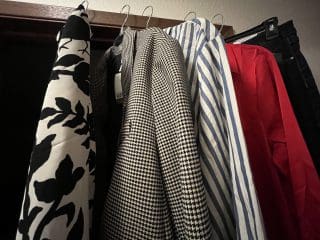Do you buy fast fashion?
 As a minimalist, I don’t do much shopping. Before the pandemic, I bought most of my clothes from the sales racks at Macy’s. Its clothes seem to be O.K. for older women.
As a minimalist, I don’t do much shopping. Before the pandemic, I bought most of my clothes from the sales racks at Macy’s. Its clothes seem to be O.K. for older women.
I did go shopping several times with my daughter Lisa, who lives in Madrid, and we shopped at H&M, Zara, and other stores. So, I got an idea of what fast Fashion is.
Lisa just came for an early Christmas celebration. We started our vacation with a four-day stay in Seattle so she could visit her friends there. I requested a trip to the Nordstrom Rack, a store that carries my unusual shoe size and sometimes has great bargains.
Lisa didn’t want to drive out to Northgate Mall where the Rack is, so she took me to some other stores instead. J. Crew turned out to be too expensive, so we shopped at H&M. She helped me pick out two blouses that she said “looked like mom.”
Back in Olympia, we did more shopping. When she was looking for gifts for her kids, I happened to find a blazer and a blouse I liked, also at H&M.
To make up for the missed Rack visit, we also took a look at Macy’s, in the mall near H&M. No blouses or coats, but I did find a new pair of jeans.
What’s fast Fashion and why is it being criticized?
Fast Fashion is clothes that are made and sold cheaply, so that people can buy new clothes often. Rather launching with the seasons four times a year, some fast Fashion brands have new offerings on an almost weekly basis.
However, fast Fashion does have a cost to the environment, people, and animals. Here are some example:
Working conditions. Low wages, long hours, child labor, forced labor, and poor working conditions are problems in fast Fashion.
The environment. Water consumption, water pollution, microfiber pollution from synthetic fabrics, chemical use, textile waste, rainforest destruction, soil degradation, and greenhouse gas emissions are issues of concern.
What can you do about fast Fashion?
Buy secondhand. You don’t use additional resources to create something new. In addition to thrift stores, try consignment stores and websites such as Vinted where you can buy from individual sellers.
Extend the life of your clothes. Clothes usually have an average life of two years, but if you can stretch that out to three years, it reduces the use of resources. Laundering tips for extending a garment’s life are wash less often, use cold water, turn dark and colorful clothes inside out to reduce fading, use the right amount of detergent, and air dry clothes.
Look for eco-friendly and sustainable brands. Some examples from a list are Vegan Outfitters, Grammar, Knickey, and Made Trade.
Since I know more about fast Fashion now after research for this article, I’ll continue to wear my clothes for years until they wear out. And with new information on the concept of eco-friendly and sustainable brands, I’ll try some of them and give them as gifts.
Originally Published on https://boomersurvive-thriveguide.typepad.com/the_survive_and_thrive_bo/

























